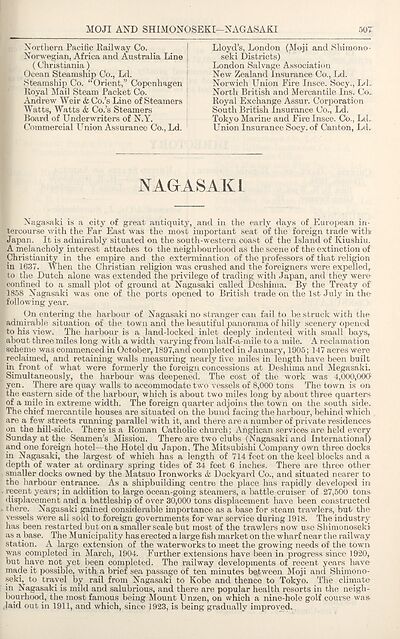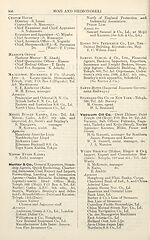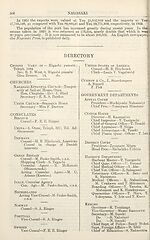1926
(563) Page 507 - Nagasaki
Download files
Complete book:
Individual page:
Thumbnail gallery: Grid view | List view

MOJI AND SHIMONOSEKI—NAGASAKI
507
Northern Pacific Railway Co.
Norwegian, Africa and Australia Line
(Christiania )
Ocean Steamship Co., Ld.
Steamship Co. “Orient,” Copenhagen
Royal Mail Steam Packet Co.
Andrew Weir & Co.’s Line of Steamers
Watts, Watts & Co.’s Steamers
Board of Underwriters of N.Y.
Commercial Union Assurance Co., Ld.
Lloyd’s, London (Moji and Shiraono-
seki Districts)
London Salvage Association
New Zealand insurance Co., Ld.
Norwich Union Fire Insce. Socy., Ld.
North British and Mercantile Ins. Co-
Royal Exchange Assur. Corporation
South British Insurance Co., Ld.
Tokyo Marine and Fire Insce. Co., Ld.
Union Insurance Socy. of Canton, Ld.
NAGASAKI
Nagasaki is a city of great antiquity, and in the early days of European in-
ftercourse with the Far East was the most important seat of the foreign trade with*
Japan. It is admirably situated on the south-western coast of the Island of Kiushiu.
A melancholy interest attaches to the neighbourhood as the scene of the extinction of
Christianity in the empire and the extermination of the professors of that religion
in 1637. When the Christian religion was crushed and the foreigners were expelled,
'• to the Dutch alone was extended the privilege of trading with Japan, and they were
; confined to a small plot of ground at Nagasaki called Deshima. By the Treaty of
1858 Nagasaki was one of the ports opened to British trade on the 1st July in the
following year.
I On entering the harbour of Nagasaki no stranger can fail to be struck with the
admirable situation of the town and the beautiful panorama of hilly scenery opened
to his view. The harbour is a land-locked inlet deeply indented with small bays,
about three miles long with a width varying from half-a-mile to a mile. A reclamation
scheme was commenced in October, 1897,and completed in January, 1905; 147 acres were
reclaimed, and retaining walls measuring nearly five miles in length have been built
in front of what were formerly the foreign concessions at Deshima and Megasaki.
Simultaneously, the harbour was deepened. The cost of the work was 4,000,000-
yen. There are quay walls to accommodate two vessels of 8,000 tons The town is on
| the eastern side of the harbour, which is about two miles long by about three quarters
of a mile in extreme width. The foreign quarter adjoins the town on the south side.
The chief mercantile houses are situated on the bund facing the harbour, behind which
are a few streets running parallel with it, and there are a number of private residences
on the hill-side. There is a Roman Catholic church; Anglican services are held every
Sunday at the Seamen’s Mission. There are two clubs (Nagasaki and International)
and one foreign hotel—the Hotel du Japon. The Mitsubishi Company own three docks
in Nagasaki, the largest of which has a length of 714 feet On the keel blocks and a
depth of water at ordinary spring tides of 34 feet 6 inches. There are three other
, smaller docks owned by the Matsuo Ironworks & Dockyard Co., and situated nearer to
the harbour entrance. As a shipbuilding centre the place has rapidly developed in
. recent years; in addition to large ocean-going steamers, a battle cruiser of 27,500 tons
displacement and a battleship of over 30,000 tons displacement have been constructed
. there. Nagasaki gained considerable importance as a base for steam trawlers, but the
vessels were all sold to foreign governments for war service during 1918. The industry
has been restarted but on a smaller scale but most of the trawlers now use Shimonoseki
as a base. The Municipality has erected a large fish market on the wharf near the railway
station. A large extension of the waterworks to meet the growing needs of the town
was completed in March, 1904. Further extensions have been in progress since 1920,
but have not yet been completed. The railway developments of recent years have
made it possible, with a brief sea passage of ten minutes between Moji and Shimono¬
seki, to travel by rail from Nagasaki to Kobe and thence to Tokyo. The climate
in Nagasaki is mild and salubrious, and there are popular health resorts in the neigh¬
bourhood, the most famous being Mount Unzen, on which a nine-hole golf course was-
Jaid out in 1911, and which, since 1923, is being gradually improved.
507
Northern Pacific Railway Co.
Norwegian, Africa and Australia Line
(Christiania )
Ocean Steamship Co., Ld.
Steamship Co. “Orient,” Copenhagen
Royal Mail Steam Packet Co.
Andrew Weir & Co.’s Line of Steamers
Watts, Watts & Co.’s Steamers
Board of Underwriters of N.Y.
Commercial Union Assurance Co., Ld.
Lloyd’s, London (Moji and Shiraono-
seki Districts)
London Salvage Association
New Zealand insurance Co., Ld.
Norwich Union Fire Insce. Socy., Ld.
North British and Mercantile Ins. Co-
Royal Exchange Assur. Corporation
South British Insurance Co., Ld.
Tokyo Marine and Fire Insce. Co., Ld.
Union Insurance Socy. of Canton, Ld.
NAGASAKI
Nagasaki is a city of great antiquity, and in the early days of European in-
ftercourse with the Far East was the most important seat of the foreign trade with*
Japan. It is admirably situated on the south-western coast of the Island of Kiushiu.
A melancholy interest attaches to the neighbourhood as the scene of the extinction of
Christianity in the empire and the extermination of the professors of that religion
in 1637. When the Christian religion was crushed and the foreigners were expelled,
'• to the Dutch alone was extended the privilege of trading with Japan, and they were
; confined to a small plot of ground at Nagasaki called Deshima. By the Treaty of
1858 Nagasaki was one of the ports opened to British trade on the 1st July in the
following year.
I On entering the harbour of Nagasaki no stranger can fail to be struck with the
admirable situation of the town and the beautiful panorama of hilly scenery opened
to his view. The harbour is a land-locked inlet deeply indented with small bays,
about three miles long with a width varying from half-a-mile to a mile. A reclamation
scheme was commenced in October, 1897,and completed in January, 1905; 147 acres were
reclaimed, and retaining walls measuring nearly five miles in length have been built
in front of what were formerly the foreign concessions at Deshima and Megasaki.
Simultaneously, the harbour was deepened. The cost of the work was 4,000,000-
yen. There are quay walls to accommodate two vessels of 8,000 tons The town is on
| the eastern side of the harbour, which is about two miles long by about three quarters
of a mile in extreme width. The foreign quarter adjoins the town on the south side.
The chief mercantile houses are situated on the bund facing the harbour, behind which
are a few streets running parallel with it, and there are a number of private residences
on the hill-side. There is a Roman Catholic church; Anglican services are held every
Sunday at the Seamen’s Mission. There are two clubs (Nagasaki and International)
and one foreign hotel—the Hotel du Japon. The Mitsubishi Company own three docks
in Nagasaki, the largest of which has a length of 714 feet On the keel blocks and a
depth of water at ordinary spring tides of 34 feet 6 inches. There are three other
, smaller docks owned by the Matsuo Ironworks & Dockyard Co., and situated nearer to
the harbour entrance. As a shipbuilding centre the place has rapidly developed in
. recent years; in addition to large ocean-going steamers, a battle cruiser of 27,500 tons
displacement and a battleship of over 30,000 tons displacement have been constructed
. there. Nagasaki gained considerable importance as a base for steam trawlers, but the
vessels were all sold to foreign governments for war service during 1918. The industry
has been restarted but on a smaller scale but most of the trawlers now use Shimonoseki
as a base. The Municipality has erected a large fish market on the wharf near the railway
station. A large extension of the waterworks to meet the growing needs of the town
was completed in March, 1904. Further extensions have been in progress since 1920,
but have not yet been completed. The railway developments of recent years have
made it possible, with a brief sea passage of ten minutes between Moji and Shimono¬
seki, to travel by rail from Nagasaki to Kobe and thence to Tokyo. The climate
in Nagasaki is mild and salubrious, and there are popular health resorts in the neigh¬
bourhood, the most famous being Mount Unzen, on which a nine-hole golf course was-
Jaid out in 1911, and which, since 1923, is being gradually improved.
Set display mode to:
![]() Universal Viewer |
Universal Viewer | ![]() Mirador |
Large image | Transcription
Mirador |
Large image | Transcription
Images and transcriptions on this page, including medium image downloads, may be used under the Creative Commons Attribution 4.0 International Licence unless otherwise stated. ![]()
| Asian directories and chronicles > 1926 > (563) Page 507 - Nagasaki |
|---|
| Permanent URL | https://digital.nls.uk/196495492 |
|---|
| Attribution and copyright: |
|
|---|---|
| Description | Volumes from the Asian 'Directory and Chronicle' series covering 1917-1941, but missing 1919 and 1923. Compiled annually from a multiplicity of local sources and research. They provide listings of each country's active corporations, foreign residents and government agencies of all nationalities for that year, together with their addresses. Content includes: various treaties; coverage of conflicts; currencies and taxes; consular fees; weights and measures; public holidays; festivals and traditions. A source of information for both Western states and communities of foreigners living in Asia. Published by Hongkong Daily Press. |
|---|---|
| Shelfmark | H3.86.1303 |
| Additional NLS resources: |

